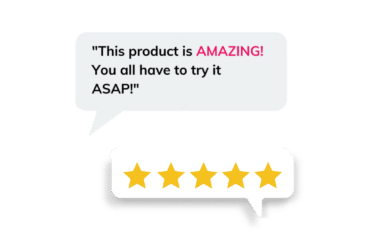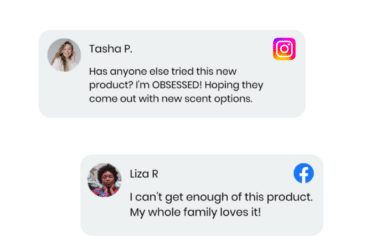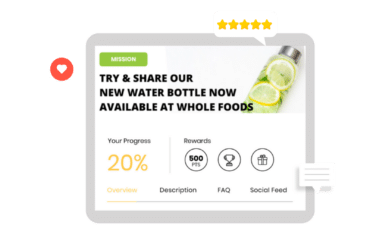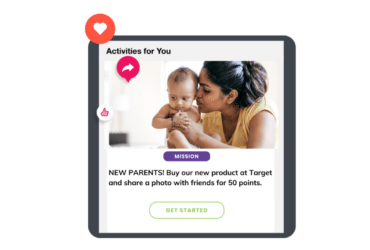The power of positive word-of-mouth is one of the fundamental truths of marketing. In a field that is undergoing seismic shifts, from data privacy to the metaverse, the superior impact of having your fans recommend your brand is undisputed. It’s more trusted. It’s more effective. And it’s more economical.
But as with most things of value, it takes work. Creating the product or service and customer experience that produces brand fans is only the first step. Inspiring them to advocate for your brand, and doing it at scale, is where Brand Advocacy Marketing comes in.
Thankfully there are many strategies to increase brand advocacy, and we’ll get to them later in this piece. First, we’ll cover what it is and why it is so important. For seasoned marketers and those ready to get started now, scroll down for the tactics.
What is Brand Advocacy, and Why is it Important to Your Brand?

- Online reviews
- Social media
- Brand communities
- Blogs
- UGC (User-generated content)
- Youtube
- Face-to-face
Brand advocacy isn’t only limited to your most loyal consumers either. Employees, company partners, potential vendors, and even influencers can all become brand advocates.
So, what makes brand advocacy so important for your brand?
For starters, brand advocacy is considered the most trusted and most credible form of advertising. Customers trust their peers above all else.
Let’s look at paid media, for example. Word-of-mouth marketing by brand advocates is up to 5 times more effective than paid media campaigns. When potential customers hear about your brand from your advocates, they’re far more likely to make a purchase (and possibly become a brand advocate themselves!)
Brand advocacy also personifies your brand. Instead of interacting with a faceless company, customers have the opportunity to engage with advocates and hear personal and meaningful stories that they may be able to better relate to.
There’s also the overwhelmingly positive return on investment. While some investment to implement a brand advocacy campaign may be required, they can produce a tremendous amount of ROI since brand advocates are not paid to champion your brand. Plus their passion often leads them to be active promoters for the long haul.
How to Find Brand Advocates
We know this all sounds great. But to have brand advocacy, you first need brand advocates.
So we gathered some tips on identifying and cultivating consumers to evangelize for your brand.
1. Seek out organic brand advocates in online channels

Searching social media platforms, discussion boards, and forums are a great place to start. This is where you can find advocates that are already getting your name out there and painting your brand in a positive light.
Pro Tip: Use social listening to monitor for mentions of your brand and identify potential advocates.
2. Identify existing advocates in your consumer database
Your existing consumers are another great place to start finding brand advocates.
Look for repeat purchasers, those who’ve left glowing reviews on your site, or those who reach out via email or social channels to engage with your brand.
If you have an online brand community, you can use it to easily gauge who your most active members and consumers are. From there, it’s only a matter of mobilizing them and nurturing them to become brand advocates.
Pro Tip: Use NPS surveys to identify your brand advocates and encourage them to spread the word about your brand.
3. Nurture consumers to become advocates

It all starts with providing a superior customer experience. For consumers today, that means showing them that you know them through personalization at every touchpoint, staying connected to them between purchases, and engaging them in an active two-way dialogue. If you want to cultivate consumers into advocates who are willing to promote your brand to the masses, you need to provide an experience worth raving about.
Providing incentives is a great way to mobilize your brand advocates quickly. Even though they love your brand, some additional motivation can’t hurt to give them an extra push to spread the word.
There are many options that will not only reward your advocates but will build their connection to your brand, including giving them behind the scenes or first access to news and updates, sharing their UGC and recognizing them on your site and social channels, or inviting them to join a VIP council or become an official brand ambassador.
Pro Tip: Everyone likes to feel recognized. Look for people already promoting your brand and send them something special as a thank you. You’ll thrill your advocate and give them more good news to spread.
How to Scale Brand Advocacy For Business Success

However, there can be some hurdles for marketers in scaling a brand advocacy program. It takes an investment in time and resources to cultivate and activate advocates.
It can be tempting to go with a paid influencer campaign that can be more quickly initiated and provide you with more control over the content, even though there is less trust in the content and more limits in regards to the scope of their advocacy.
There’s also the measurement factor. Without certain tools, like an online brand community, it can be hard to measure overall results and ensure that you’re getting to where you want to be.
One approach to brand advocacy marketing is to run single advocacy campaigns, like sending an email to your consumers post-purchase with an offer of free samples in exchange for a product review.
While this can be effective, one-off campaigns require consistent monitoring and management. We all know most marketing teams are short-staffed, so scaling your ability to reach consumers while minimizing the added work for your team is a top priority.
Thankfully there are better options that make it easy to nurture and scale your consumer’s WOM.
With a platform such as an online brand community, you can give potential brand advocates the opportunity to experience your brand in a way that is meaningful to them outside of their purchase, while also giving them a way to easily share that experience with others.
Mobilizing brand advocates with an online brand community
Online communities make scaling your consumer outreach activities easy. They give you a platform to assemble all of your die-hard, loyal customers and mobilize them to become brand advocates.
It’s possible to do some of this with channels you may already employ, such as a Facebook group. However, there are a number of benefits that differentiate a social media community from a true online brand community platform. An online brand community can give you access to features that you’ll want for scaling your brand advocacy strategy, such as activities and discussions to build your consumer relationships, reward systems to provide incentives, and ownership of your zero-party data, proving value for so much more than brand advocacy campaigns alone.
Delivering personalized experiences and making it easy to share

It’s important to look for a platform that makes it easy to target and personalize offers and experiences. Let’s say you want to generate word-of-mouth and reviews for a product targeting newer parents—you wouldn’t want to send it to someone with older children or no children at all. Delivering these personalized experiences helps create excitement and passion for a brand that sparks meaningful advocacy.
Your platform should also make it easy to help advocates get the word out. For example, TINT’s Single-click Sharing tool allows advocates to seamlessly share UGC, recommendations, and reviews from right within the platform.
Prompting friends and followers to act and convert
Scaling your brand advocacy campaigns means harnessing the power of your advocates to share offers from your brand with their network.
As an example, TINT ran a campaign for a health & beauty aids (HBA) brand where members were provided with a link to share with friends and followers to opt-in for a free sample. We initially activated just 4,800 community members to participate in the campaign, and over 150,000 samples were redeemed using the link, demonstrating the power of advocates to amplify messaging.
Product trial campaigns like this one can also help create brand new advocates for your brand, continuing the cycle.
Building Brand Advocacy is a Crucial Step For Brands Looking to Grow

From building authenticity to personalizing your brand on a whole new level, building brand advocacy is a marketing channel that provides tremendous value.
Our tips can help you get the most out of your brand advocacy campaigns and ensure that you’re getting the maximum ROI possible.
Your audience is waiting.
Questions about How to Build Brand Advocacy?
If you have questions about how to build brand advocacy or how the TINT community platform can help, reach out to us. We’re here to help.
Interested in more?



